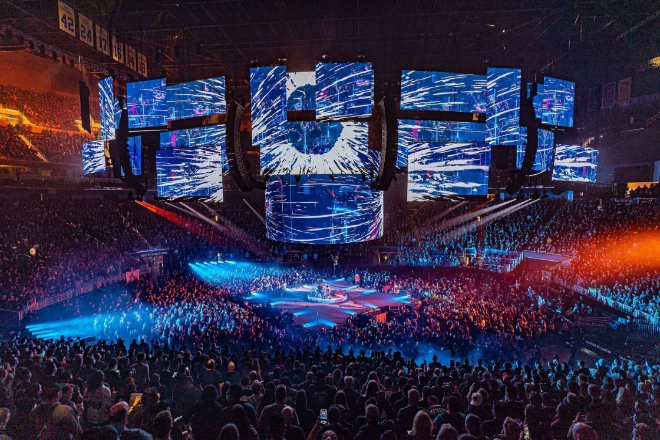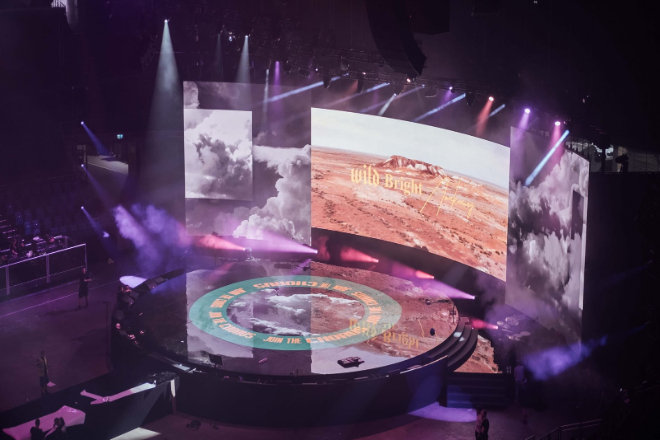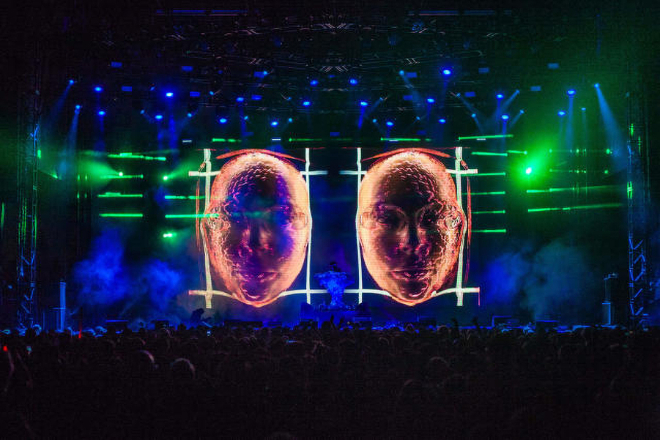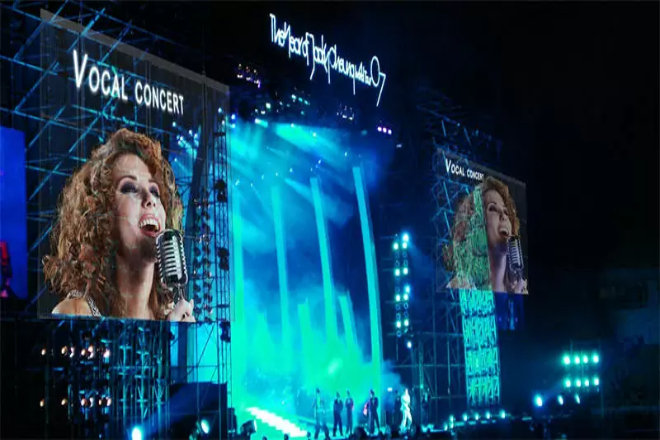Introducción
When the stage lights are on, an Pantalla LED can take the audience into the universe, the magic forest, or even a completely fictional fantasy world.
Have you ever wondered how those amazing stage wonders are achieved? This article will answer your questions in detail.
Tabla de contenido
1. A brief introduction to fantasy visual shapes

1). Fusion of fantasy and reality
The LED display screen is like a magical canvas that can turn pictures that do not exist in reality into real scenes in front of you, bringing the audience into a fantasy world.
Por ejemplo, en un escenario performance, the background LED display screen can instantly turn into a mysterious starry sky, with stars twinkling and meteors passing by, making people seem to be standing in the universe.
If the performance is an ancient myth, the display screen can turn into an ancient castle surrounded by a magical halo, making the audience seem to have traveled to that fantasy era.
This combination of fantasy scenes and realistic stage performances can create a super shocking fantasy atmosphere that immerses the audience.
2). Resonance of emotions and vision
The LED display screen can also make the audience feel different emotions through various visual elements and resonate with the content of the performance.
If you want to create a mysterious feeling, the LED display can use dark tones, such as dark blue and dark purple.
There can be some blurred shadows, strange symbols, or a dark path in the picture, which makes people feel that there are many unknown secrets hidden in it.
The audience will be attracted by this mysterious atmosphere and their curiosity will be aroused.
To convey a fantasy feel, you can use bright colors, such as a colorful magic forest, glowing plants, flying elves, or a castle floating in the air.
These fantasy pictures will make the audience feel that the world in front of them is full of wonders and surprises as if they have become part of the story.
In joyful occasions, such as festivals or children’s performances, LED displays can use bright colors, such as red, yellow, and blue.
The picture can be a lively amusement park, cheerful cartoon characters dancing, or a group of small animals having a party.
This picture will make the audience feel happy and excited and pass on the joyful atmosphere to everyone.
If you want to create a horror atmosphere, the display screen can use dark colors, such as black and dark gray. There can be some horror elements in the picture, such as ghosts floating by, spider webs, and blood-stained scenes.
People will be a little scared when they see it, but they can’t help being attracted. This tense and exciting feeling is also suitable for some horror-themed performances.
In short, LED display screens can create various fantasy scenes through visual elements such as color and picture content according to different themes and emotional needs so that the audience can have a strong experience both visually and emotionally and perfectly integrate with the content of the performance.
2. LED display screens suitable for stage

This kind of display screen is like a “temporary actor” on the stage, which is very flexible. It is like a puzzle, composed of small modules, which can be quickly spliced together according to the size and shape of the stage.
It is fast to assemble and easy to disassemble, especially suitable for those stages that have to be removed after use, such as music festivals or temporary commercial activities.
It is high in brightness, and the audience can see it clearly even in the outdoor sun. Moreover, it can be quickly built and debugged without taking up too much time, which is very suitable for activities with tight time and heavy tasks.

2). Pantalla LED fija para interiores
This display is like a “resident guest” on the stage, usually installed indoors, such as theaters and studios.
It is like an oversized HDTV screen with high brightness and contrast, and the picture details are as clear as looking at a painting up close.
Its colors are particularly bright and can display a wide color gamut, such as red can be as red as a ripe cherry, and blue can be as blue as the deep sea.
This display is very suitable for fixed places with high requirements for picture quality, such as the stage background of the theater, so that the audience can enjoy the performance while the background picture can also become part of the visual enjoyment.

This display is like a “creative artist” on the stage, and can design various strange shapes according to the stage, such as a curved curved screen, a ring screen surrounding the audience, and even a cylindrical, spherical and other strange shapes.
It can not only display the picture but also perfectly integrate with the stage design to create a bright effect.
For example, in a fantasy-themed stage play, the creative LED display can be made into a huge “magic ball” with fantasy images playing inside, making the audience feel as if they are in a magic world.

4). Special-shaped LED display
This display is like a “Transformer” on the stage, which can be transformed into various strange shapes according to the needs of the stage.
For example, on the stage of a large concert, it can be made into a huge “wing” shape or a “halo” surrounding the stage.
This display can make the stage look more creative and more personalized and is especially suitable for performances that pursue unique visual effects, such as some large concerts or immersive exhibitions, which can make the audience feel the unique charm of the stage.

This display is like a “magician” on the stage. It looks almost transparent but can display clear pictures. It’s like a thin screen is attached to the glass, and the picture and the stage background or actors can blend with each other.
For example, in a modern dance performance, a transparent LED display can be attached to the glass floor of the stage.
As the dancers move, various light and shadow effects are displayed on the floor, making the audience seem to see the dancers dancing in the light and shadow, adding a sense of layering and mystery to the stage.
In short, these different types of LED display screens have their own characteristics. You can choose according to the specific needs and budget of the stage to make the visual effect of the stage more outstanding.
3. Specific ways for LED display screens to create fantasy visual shapes

1). The magic of color and light and shadow
1.1). Color application skills
LED display screens are like a super palette, which can adjust a variety of colors and make smooth transitions between colors to create super cool visual effects.
- The contrast of warm and cold tones:
Imagine that there is a mysterious forest on the stage. Use dark green and blue tones to show the darkness and mystery of the forest, and add some warm yellow light spots, just like fireflies flying.
This contrast of cold and warm can make the audience feel the mystery and vitality of the forest at once.
- Complementary color matching:
For example, red and green, blue and orange colors are put together, and the visual impact is particularly strong. In fantasy scenes, complementary colors can be used to highlight the key points.
For example, a magic circle, with blue light as the background and orange lines in the middle to outline the outline of the magic circle, the audience will be attracted at a glance.
- Gradient effect:
LED display can easily make the effect of slowly transitioning from one color to another.
For example, from dark blue to light blue, and then to transparent, it feels like the sea water from the deep sea to the shallows.
This gradient effect is particularly realistic when used in the underwater world or sky scenes.
1.2). Creation of light and shadow effects
LED display has a high brillo and can adjust the intensity of light, which makes it very promising in terms of light and shadow effects.
- The contrast of light and dark:
It’s like drawing a light and shadow painting on the stage. For example, in an ancient castle scene, the main body of the castle is lit with warm yellow light, which looks very warm, while the shadow part around the castle is dark blue, which makes the whole picture more layered.
The audience’s eyes will naturally be attracted to the bright place, and they can also feel the mystery brought by the shadow.
- Beam projection:
Imagine that a beam of light suddenly shoots out from the display on the stage and passes through the smoke on the stage, just like the special effects in the movie. This beam effect can be used to create a sacred, mysterious or tense atmosphere.
For example, in a fantasy story, when the protagonist gets a magic prop, a beam of light falls from the sky and focuses on him, and the audience can immediately feel the importance of this moment.
- Shadow effect:
Shadows can not only increase the three-dimensional sense but also make the picture more story-like.
For example, a huge monster is displayed on the LED display, and its shadow is projected on the stage so the audience can feel the monster’s hugeness and threat.
This shadow effect can perfectly integrate the virtual picture with the real stage, making the audience feel that the monster is really in front of them.
2). Construction of dynamic images and virtual scenes
2.1). Presentation of dynamic images
LED display screens can not only display static pictures, but also display smooth dynamic pictures, just like playing a movie.
- Flying elves:
Suppose there is a group of actors dancing on the stage. The LED display screen can synchronously display a group of elves flying around them. The movements of the elves can be adjusted according to the rhythm of the music.
For example, when the music rhythm is fast, the elves fly faster; when the rhythm is slow, the elves float slowly. This dynamic picture, combined with the performance of the actors, can make the audience feel that they are really in a fantasy world.
- Rotating magic circle:
At the critical moment of the performance, a rotating magic circle can appear on the LED display. The rotation speed of the magic circle can be changed according to the tension of the plot.
For example, when the protagonist casts magic, the magic circle rotates very fast, and there is light flashing around, so the audience can feel the power and mystery of magic.
2.2). Construction of virtual scenes
By splicing LED display screens, you can create a super large virtual scene, making the stage infinitely large.
- Virtual buildings:
For example, in a fantasy story, a huge castle is needed. Through 3D modeling and rendering technology, a castle with rich details can be built on the display screen, and even the brick and stone texture of the castle can be seen clearly.
Then, combine this virtual castle with the physical props on the stage (such as some small flowers, plants, and stones), and the audience will feel that the castle is really in front of them. When the actors walk into the castle, it is like walking into the real world.
- Virtual natural landscape:
It is also easy to create a vast grassland or forest. Through the splicing of display screens, the audience can see the boundless natural landscape.
For example, on the stage, actors can walk into a virtual forest and interact with virtual trees and animals.
The audience sees not only the performance of the actors, but also the virtual world behind them. This combination of reality and illusion is particularly magical.
In short, LED display screens can turn an ordinary stage into a world full of fantasy through color, light and shadow, dynamic images and audience interaction, allowing the audience to immerse themselves in it and experience a different visual feast.
4. Classic stage case analysis
1). Taylor Swift’s “Times Tour”
1.1). Color application and light and shadow effects:
Taylor Swift’s concert screen uses 27,000 embedded LED ice screens. The screen pixel spacing is wide, which avoids the appearance of moiré and makes the picture clearer.
This high-transparency ice screen makes the stage background appear light and transparent, and at the same time, it cooperates with the stage lighting to create a dreamy light and shadow effect.
1.2). Dynamic image design:
The LED screen of the concert not only displays static images, but also displays dynamic images such as lyrics and animations according to the rhythm of the music and emotional changes, which enhances the audience’s sense of immersion.
1.3). Virtual scene construction:
Through the combination of LED screen and stage lighting, an immersive three-dimensional space is created, making the audience feel as if they are in a virtual world.
1.4). Audience interaction:
Although the audience mainly participates through visual experience, the dynamic effects and lyrics display of the LED screen make it easier for the audience to follow the rhythm and enhance interactivity.
1.5). Inspiration and reference:
The success of this concert lies in the close combination of LED screen with stage design, lighting effects and music rhythm to create an immersive audio-visual experience.
This model provides reference for other concerts, especially in screen selection and visual effect design.
2). Imagine Dragons World Tour
2.1). Color application and light and shadow effects:
The Imagine Dragons concert used 300 square meters of UT-390 transparent screens and 300 square meters of D590 rental screens to build an outdoor super-large and gorgeous technological stage.
The high transparency and high definition of the transparent screen make the stage background appear more three-dimensional and real.
2.2). Dynamic image design:
The LED screen displays dynamic images synchronized with the rhythm of the music, such as a virtual space with interlaced light and shadow, which enhances the visual impact of the stage.
2.3). Virtual scene construction:
Through the splicing and layout of the LED screen, a virtual stage background, such as the starry sky and the ocean, is constructed to allow the audience to feel different scene atmospheres.
2.4). Audience interaction:
The LED screen is perfectly integrated with elements such as on-site lighting and fireworks to create a dreamlike audio-visual feast, allowing the audience to immerse themselves in the dual enjoyment of music and vision.
2.5). Inspiration and reference:
The concert of the Imagine Dragons band demonstrated the combined use of transparent screens and rental screens, which not only improved the visual effect, but also reduced the difficulty and cost of stage construction.
This model provides a reference for other concerts, especially in terms of screen selection and stage layout.
5. Future development trends and prospects of stage LED display screens

1). Technological innovation and breakthroughs
In the future, LED display technology will continue to advance and bring more shocking visual experiences. For example, screens with higher resolution and higher refresh rates will become popular, making the picture clearer and smoother.
Technologies like MicroLED and MiniLED, which can provide brighter colors and higher contrast, will be widely used in stage performances in the future.
In addition, the potential for the application of new LED displays is huge. Transparent LED displays can create unique visual effects in stage performances, such as allowing the audience to see the scene behind the screen.
Flexible LED displays can be bent and folded, bringing more creative space to stage design. There are also micro-LED displays, which are thin and light with high resolution and can be used for small equipment or props on the stage.
2). Artistic creation and integration
Future stage performances will integrate more art forms, such as music, dance, drama and installation art.
LED displays will play an important role in this, such as enhancing visual impact through dynamic images synchronized with the rhythm of music and light and shadow effects coordinated with dance movements.
At the same time, the rise of multimedia art will combine LED displays with technologies such as virtual reality and augmented reality to create an immersive artistic experience.
For example, in some art exhibitions, LED screens are used to create a “virtual-real symbiosis” exhibition format.
Artists can give their works digital vitality such as dynamic light and shadow and audio-visual interaction through programming on the basis of traditional paintings.
This fusion not only broadens the boundaries of art, but also brings a new sensory experience to the audience.
3). Social culture and market demand
As the audience’s aesthetic concepts change, their demand for fantasy, creativity and immersive experience continues to increase.
LED screens can meet these needs and bring high-quality visual enjoyment to the audience through high-resolution, high-refresh-rate and high-contrast images.
From the perspective of market demand, the market size of LED screens is constantly expanding.
In 2024, the global LED rental screen market size is expected to reach 10.347 billion yuan, an annual growth of 5%. This shows that the market demand for LED screens continues to grow, especially in the fields of commercial performances, cultural tourism and art exhibitions.
In the future, LED screens will play a unique value in different fields. In commercial performances, they can create fantastic stage effects to attract audiences.
In cultural tourism, LED screens can be used to display historical scenes or cultural stories to enhance the experience of tourists. In art exhibitions, they can be combined with artworks to create interactive exhibitions.
In short, the application of LED displays in future stage performances will be more extensive and in-depth.
Through technological innovation, artistic creation integration and a keen grasp of market demand, LED displays will bring more fantastic and unique visual experiences to stage performances and promote the development of stage performance art to a higher level.
6. Conclusión
In the final analysis, LED displays are like magicians on the stage, quietly creating surprises and shocks. Whether it is fantasy, romance or horror, it can play well. The future stage will definitely not be without its “light and shadow blessing.”
Finalmente, si quieres saber más sobre las pantallas LED, Por favor póngase en contacto con nosotros.
